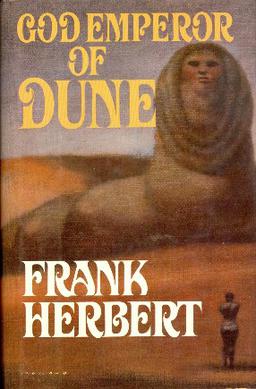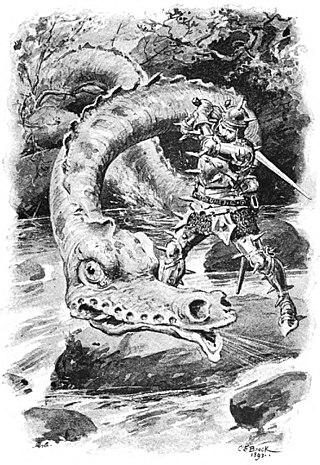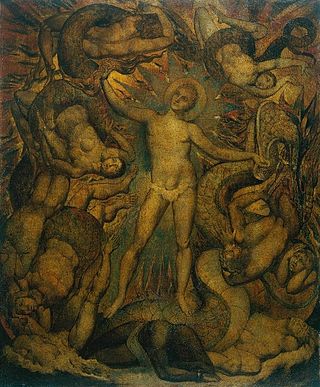
God Emperor of Dune is a science fiction novel by American writer Frank Herbert, published in 1981. The fourth in his Dune series of six novels, it was ranked as the No. 11 hardcover fiction best seller of 1981 by Publishers Weekly.

Kaiju is a Japanese term that is commonly associated with media involving giant monsters. A subgenre of science fiction, it was created by Eiji Tsuburaya and Ishirō Honda. The term can also refer to the giant monsters themselves, which are usually depicted attacking major cities and battling either the military or other monsters.

Douglas Richard TenNapel is an American animator, writer, cartoonist, video game designer, and comic book artist whose work has encompassed animated television, video games, and comic books. He is best known for creating Earthworm Jim, a character that spawned a video game series, animated series, and a toy line. He is also the creator of the animated television series Catscratch (2005–2007), which aired on Nickelodeon, and was itself a loose adaptation of TenNapel's comic book limited series Gear.

The Spacing Guild is an organization in Frank Herbert's science fiction Dune universe that possesses a monopoly on interstellar travel and banking. Guild Navigators use the drug melange to achieve limited prescience, a form of precognition that allows them to successfully navigate "folded space" and safely guide enormous starships called heighliners across interstellar space instantaneously.

A sandworm is a fictional extraterrestrial creature that appears in the Dune novels written by Frank Herbert, first introduced in Dune (1965).

The Mongolian death worm is a creature alleged to exist in the Gobi Desert. Investigations into the legendary creature have been pursued by amateur cryptozoologists and credited academics alike, but there has been little evidence found to support its existence. It can be considered a Cryptid or a mythological animal.

Dune is an American science fiction media franchise that originated with the 1965 novel Dune by Frank Herbert and has continued to add new publications. Dune is frequently described as the best-selling science fiction novel in history. It won the inaugural Nebula Award for Best Novel and the Hugo Award in 1966 and was later adapted into a 1984 film, a 2000 television miniseries, and a two-part film series with the first film in 2021 and a sequel in 2024. Herbert wrote five sequels, the first two of which were concomitantly adapted as a 2003 miniseries. Dune has also inspired tabletop games and a series of video games. Since 2009, the names of planets from the Dune novels have been adopted for the real-world nomenclature of plains and other features on Saturn's moon Titan.
The Star Trek franchise has produced a large number of novels, comic books, video games, and other materials, which are generally considered non-canon.
The Norse mythology, preserved ancient Icelandic texts such as the Poetic Edda, the Prose Edda, and other lays and sagas, was little known outside Scandinavia until the 19th century. With the widespread publication of Norse myths and legends at this time, references to the Norse gods and heroes spread into European literary culture, especially in Scandinavia, Germany, and Britain. In the later 20th century, references to Norse mythology became common in science fiction and fantasy literature, role-playing games, and eventually other cultural products such as Japanese animation. Storytelling was an important aspect of Norse mythology and centuries later, with the rediscovery of the myth, Norse mythology once again relies on the impacts of storytelling to spread its agenda.

The giant squid's elusive nature and fearsome appearance have long made it a popular subject of legends and folk tales. Its popularity as an image continues today with references and depictions in literature, film, television, and video games.

References to the fictional kraken are found in film, literature, television, and other popular culture forms.

Mary Shelley's 1818 novel Frankenstein; or, The Modern Prometheus, and the famous character of Frankenstein's monster, have influenced popular culture for at least a century. The work has inspired numerous films, television programs, video games and derivative works. The character of the Monster remains one of the most recognized icons in horror fiction.

Worms are many different distantly related bilateral animals that typically have a long cylindrical tube-like body, no limbs, and usually no eyes.
A worm is an animal with a long cylindrical tube-like body and no limbs.

Worms have played major roles in world mythology and its associated literatures. The word was often used to describe creatures now classified as snakes, lindworms, serpents and dragons. Its symbolic meaning is divided between death and renewal.

The mythology relating to this subject arises from Ancient Middle East and Jewish origins. The Hebrew monster Leviathan found in the Book of Job has in particular given rise to many incarnations in popular culture, film, and literature. However, this article includes subjects with no direct connection to ancient sources.













